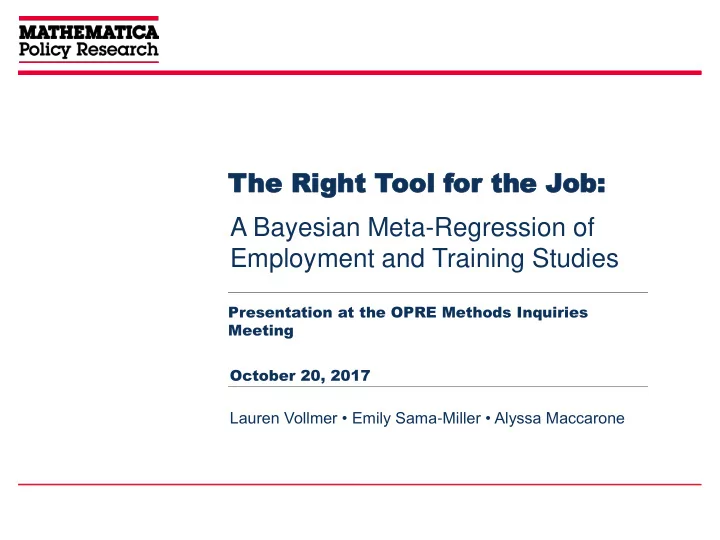

The he Right Right Tool ool for the or the Job: ob: A Bayesian Meta-Regression of Employment and Training Studies Presentation at the OPRE Methods Inquiries Meeting October 20, 2017 Lauren Vollmer • Emily Sama - Miller • Alyssa Maccarone
Motivation 2 2
What is Meta-Regression? 𝑍 𝑗 = 𝛽 + 𝛾𝑌 𝑗 + 𝜁 𝑗 • 𝑍 𝑗 : earnings for person 𝑗 • 𝑌 𝑗 : background information about person 𝑗 3 3
What is Meta-Regression? 𝑍 𝑗 = 𝛽 + 𝛾𝑌 𝑗 + 𝜁 𝑗 • 𝑍 𝑗 : estimate in study 𝑗 • 𝑌 𝑗 : background information about study 𝑗 4 4
Why Meta-Regression? 5 5
Why Meta-Regression? 6 6
Why Meta-Regression? • Synthesize information rigorously across related studies – Overall effect across studies – Average effect across outcomes within a study • Quantify relationships between study features and outcomes • Weight observations according to their precision 7 7
Why Bayesian Meta-Regression? 8 8
Why Bayesian Meta-Regression? • Incorporate prior information 9 9
Why Bayesian Meta-Regression? • Incorporate prior information – “Borrow strength” from related studies – Examine variation in effects without sacrificing precision – Enhance the plausibility of the estimates 10 10
Why Bayesian Meta-Regression? • Incorporate prior information – “Borrow strength” from related studies – Examine variation in effects without sacrificing precision – Enhance the plausibility of the estimates • Describe conclusions probabilistically 11 11
Why Bayesian Meta-Regression? • Incorporate prior information – “Borrow strength” from related studies – Examine variation in effects without sacrificing precision – Enhance the plausibility of the estimates • Describe conclusions probabilistically – “There is a 15 percent chance that intervention X improves outcome Y by 5 percent or more.” – Use plain, intuitive language – Focus on practically meaningful thresholds – Avoid binary or “bright line” thinking 12 12
Example: Employment Strategies Evidence Review (ESER) 13 13
Employment Strategies Evidence Review • Project for the Office of Planning, Research, and Evaluation at the Administration for Children and Families • Systematic review of literature on employment and training programs and policies for low-income workers – Published between 1990 and 2014 – Conducted in the US, UK, or Canada • Reviewers rated the quality of each study’s causal evidence as high , moderate , or low 14 14
An ESER Study Outcome 1 Strategy 1 Outcome 2 Strategy 2 Target Outcome 3 Strategy 3 Population … … Outcome 𝑙 Strategy 𝑡 Intervention 15 15
ESER Meta-Regression Research Questions 1. What works? – Past interventions – Specific employment strategies 2. What works in which domains? 3. What works for which populations? 4. What works for which populations in which domains? 16 16
Meta-Regression Implementation • Standardize impact estimates using effect sizes – ESER studies did not provide adequate data to calculate effect sizes for continuous outcomes (e.g. earnings) – Restricted attention to binary outcomes: • Employment • Public assistance receipt • Educational attainment – Use the odds ratio effect size metric • Align the sign of favorable/unfavorable impacts across outcomes – A positive estimate should denote a favorable impact – Public assistance receipt → independence from public assistance 17 17
Meta-Regression Model: Main Effects 𝑇 𝑄 𝑇 𝐸 𝑧 𝑗𝑘 = 𝛽 + 𝑏 𝑘 + 𝑐 𝑒 𝑗 + 𝑑 𝑡 𝐽 𝑡 𝑘 + 𝑞 𝐽 𝑞 𝑘 + 𝑔 𝑡𝑒 𝐽 𝑡 𝑘 𝐽 𝑒 𝑗 𝑡=1 𝑞=1 𝑡=1 𝑒=1 𝑄 𝐸 𝑇 𝑄 𝐸 𝑇 𝑄 + ℎ 𝑞𝑒 𝐽 𝑞 𝑘 𝐽 𝑒 𝑗 + 𝑚 𝑡𝑞 𝐽 𝑡 𝑘 𝐽 𝑞 𝑘 + 𝑛 𝑒𝑡𝑞 𝐽 𝑒 𝑗 𝐽 𝑡 𝑘 𝐽 𝑞 𝑘 𝑞=1 𝑒=1 𝑡=1 𝑞=1 𝑒=1 𝑡=1 𝑞=1 + 𝜁 𝑗𝑘 2 𝜁 𝑗𝑘 ∼ 𝑂(0, 𝜐 2 + 𝑡 𝑗𝑘 • outcome domain • employment strategy • population characteristic 18 18
Meta-Regression Model: Interaction Terms 𝑇 𝑄 𝑇 𝐸 𝑧 𝑗𝑘 = 𝛽 + 𝑏 𝑘 + 𝑐 𝑒 𝑗 + 𝑑 𝑡 𝐽 𝑡 𝑘 + 𝑞 𝐽 𝑞 𝑘 + 𝑔 𝑡𝑒 𝐽 𝑡 𝑘 𝐽 𝑒 𝑗 𝑡=1 𝑞=1 𝑡=1 𝑒=1 𝑄 𝐸 𝑇 𝑄 𝐸 𝑇 𝑄 + ℎ 𝑞𝑒 𝐽 𝑞 𝑘 𝐽 𝑒 𝑗 + 𝑚 𝑡𝑞 𝐽 𝑡 𝑘 𝐽 𝑞 𝑘 + 𝑛 𝑒𝑡𝑞 𝐽 𝑒 𝑗 𝐽 𝑡 𝑘 𝐽 𝑞 𝑘 𝑞=1 𝑒=1 𝑡=1 𝑞=1 𝑒=1 𝑡=1 𝑞=1 + 𝜁 𝑗𝑘 2 𝜁 𝑗𝑘 ∼ 𝑂(0, 𝜐 2 + 𝑡 𝑗𝑘 • strategy by domain • target population by domain • strategy by target population • strategy by target population by domain 19 19
Results 20 20
Intervention Impacts 21 21
Strategy Impacts Any Improvement Improvement Strategy improvement of 5% or of 10% or (%) more (%) more (%) Financial incentives and sanctions 93.02 1.40 0.01 Education 92.77 0.69 0.00 Work experience 92.59 1.20 0.00 Training 92.19 0.73 0.00 Work readiness activities 89.63 0.25 0.00 Job development 88.73 0.41 0.00 Case management 88.33 0.33 0.00 Health services 88.13 0.64 0.00 Employment and retention services 81.59 0.18 0.00 Supportive services 81.05 0.05 0.00 22 22
Strategy-by-Domain Impacts 23 23
Questions? 24 24
For More Information • Lauren Vollmer – lvollmer@mathematica-mpr.com • Emily Sama-Miller – esamamiller@mathematica-mpr.com • Alyssa Maccarone – amaccarone@mathematica-mpr.com https://employmentstrategies.acf.hhs.gov/ 25 25
Appendix: Meta-Regression Priors Interaction Hyperpriors and Main Effects Terms Variance Components 2 𝛽 ∼ 𝑂 0, 10 𝜈 𝑑 ∼ 𝑂 0, 1 𝑔 𝑡𝑒 ∼ 𝑂 0, 𝜏 𝑔 2 2 𝑏 𝑘 ∼ 𝑂 0, 𝜏 𝑏 𝜈 ∼ 𝑂(0, 1) ℎ 𝑞𝑒 ∼ 𝑂 0, 𝜏 ℎ 2 2 𝜈 𝑚 ∼ 𝑂(0, 1) 𝑐 𝑒 𝑗 ∼ 𝑂 0, 𝜏 𝑐 𝑚 𝑡𝑞 ∼ 𝑂 𝜈 𝑚 , 𝜏 𝑚 2 2 𝑑 𝑡 ∼ 𝑂 𝜈 𝑑 , 𝜏 𝑑 𝑛 𝑒𝑡𝑞 ∼ 𝑂 0, 𝜏 𝑛 𝜐 ∼ half− 𝑂(0, 2.5) 2 𝜏 𝑦 ∼ half− 𝑂(0, 𝜚 2 ) 𝑞 ∼ 𝑂 𝜈 , 𝜏 𝜚 ∼ Unif (0, 5) 26 26
Recommend
More recommend